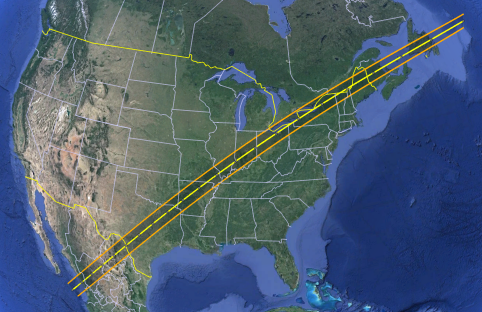Path of the 2024 April 8th Total Solar Eclipse |
|
The position of the umbral shadow path across North America has been accurately determined and is now available via the link given further below. Most notably, this path incorporates adjustments that account for the topographic elevation, both around the limb of the Moon and on the surface of the Earth. It therefore provides a reliable guide for intrepid observers who may wish to venture close to the path limits and witness prolonged, and potentially profound, edge effects around the time of maximum eclipse (weather-permitting).
|
|
The link provides access to a KML file which can be viewed in Google Earth. The cropped screen-grab image below (left) depicts how the path appears on initial loading, showing the extents of the path over Mexico, USA, and Canada, together with the central line and timing markers.
|
| Path band (true) |
Shaded area between the true-limb path limits. |
| Path limits (true) |
The true-limb path limits, accounting for the topocentric lunar limb profile. |
| Limit line ±1σ (true) |
Variation in the across-path position of the true-limb limit lines, accounting for the uncertainty in the eclipse solar radius (±0.05" at one au). |
| Limit line UTC (true) |
Times of maximum true-limb eclipse at 5-minute intervals. |
| Central line |
Trace of the intersection between the shadow axis and the surface of the Earth. |
| Central line UTC |
Times of maximum central eclipse at 5-minute intervals. |
| Path limits (mean) |
The mean-limb path limits, corresponding to the mean lunar radius. |
| Limit line UTC (mean) |
Times of maximum mean-limb eclipse at 5-minute intervals. |
|
Note that all UTC timing markers are active and can be clicked to display event data.
|
|
By definition, the duration of the eclipse on either the true-limb or the mean-limb limit lines is zero, corresponding to simultaneous second and third contacts at the time of maximum eclipse. However, it must be emphasized that, on the mean-limb path limits, no such events exist in reality as the lunar mean limb is not an observable quantity. Only the true-limb-based data has any connection with what could be seen in the sky at the time of the eclipse.
|
|
Despite this, the mean-limb path limits come in handy when they are used with the corresponding true-limb limits to define a so-called "graze zone". This zone can be a few kilometres wide and usually lies exterior to the true-limb limits. This is certainly the case for TSE2024 on the northern path limit, wherein observers will miss-out on totality but still see a great deal of limb activity from Baily's beads (a veritable broken total eclipse).
|
|
However, at the southern path limit the situation is somewhat reversed, particularly through Mexico and Texas. Here the graze zone lies interior to the true-limb path limit, which means that totality will still be possible despite being outside the mean-limb limit. This zone is also quite narrow (<400 m) and in fact gradually reduces in width until around 18:40 UTC when the limit lines cross each other. Therefore, over much of the southern limit in Mexico and USA, the graze zone remains quite narrow.
|
|
The mean-limb path limits are also useful in providing clear definitions of broken eclipses, especially in the region of the transition point of a hydrid eclipse. This is covered in more detail at the bottom of this accompanying web-page: True Umbral and Antumbral Surfaces of the Lunar Shadow.
|
| Planetary ephemeris |
JPL/DE440. |
| Astrometric method |
Light-time + gravitational light deflection + planetary aberration. |
| Astrometric origin |
Hybrid (topocentric & geocentric). |
| Earth orientation model |
IAU2006A-EQX + EOP (TT–UT1 = +69.2015 s). |
| Earth orientation parameters |
TAI–UTC = +37 s, UT1–UTC = –0.0175 s, polar motion = (–0.015, +0.359)". |
| Moon orientation model |
ME421 (relative to PA440). |
| Mean solar radius |
(696221 ± 36) km or (959.95 ± 0.05)" at one au. |
| Mean lunar radius |
1738.091 km. |
| Terrestrial radii |
6378.137 km, 6356.752 km (WGS84). |
| Lunar DEM |
SLDEM2015/LDEM128 (256/128 pixels per degree). |
| Terrestrial DEM |
Earth2014 (60 pixels per degree) + EGM96 geoid undulation. |
| Software |
EclipseView, LimbView & SkyWare (proprietary). |

